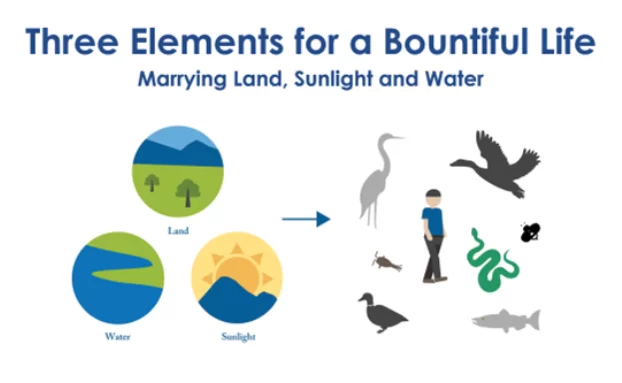By David Guy, Northern California Water President
California’s Sacramento Valley is a land of extraordinary abundance—teeming with wildlife, shaped by water, and home to amazing communities and generations of farmers and ranchers. The Sacramento Valley is increasingly turning to an age-old concept with modern relevance: mimicry. By emulating natural systems, farmers, conservationists, land stewards, and water suppliers are reshaping how we manage water, soil, and habitat—paving the way toward a more resilient future. Today, this region is pioneering a new way of thinking about land use: one where working lands and natural systems are not at odds, but in harmony, through the principle of ecological mimicry.
What Is Mimicry in Ecology?
Ecological mimicry means designing human-managed landscapes that imitate the structure, function, and processes of natural ecosystems. In the Sacramento Valley, this approach is helping us restore balance where water, our communities, agriculture, and wildlife intersect. Rather than fearing or fighting nature, mimicry works with it. Rather than choosing between nature and agriculture, farmers, scientists, and conservationists are collaborating to make both thrive together. Ecological function for farming and nature depend upon the same basic ingredients–a special blend of land, sunlight, and water. The key thus lies in mimicking natural processes—from seasonal flooding to soil regeneration—to support wildlife and ecosystem health while maintaining productive farms and ranches.

Why It Matters in the Sacramento Valley
The Sacramento Valley is at the center of California’s water supply system, with the cornerstone reservoirs for the Central Valley and State Water Project. It is home to millions of acres of farmland, and it serves as a vital migratory route for both birds along the Pacific Flyway and anadromous Chinook salmon. This mosaic of use presents challenges—but also opportunities for innovation. Mimicry offers a framework to reconnect these systems from ridgetop to river mouth in ways that are economically and ecologically productive.
Why Mimicry Works
Mimicking nature provides multiple benefits:
- Biodiversity: Mimicked landscapes support a wide range of species, from birds and fish to insects and amphibians.
- Resilience: Natural processes like flooding and soil regeneration increase the Valley’s ability to withstand drought, fire, and weather whiplash.
- Sustainable Habitat: A place that species recognize and have adapted, increasing the likelihood that they will out-compete invasive and introduced species.
- Productivity: Healthier ecosystems lead to healthier soil, cleaner water, and more sustainable yields for farmers and ranchers.
- Cost-Effective Solutions: Nature-based infrastructure often costs less than traditional infrastructure—and delivers multiple co-benefits.
- Partnerships: Mimicry fosters collaboration between landowners, water suppliers, scientists, conservation organizations, and tribes, creating shared solutions.
A New Way Forward
The Sacramento Valley’s future depends on how well we manage the convergence of agricultural production, environmental needs, and water security. Mimicry is not a return to a pristine past, but a bridge to a functional, living future—where farms, fish, and fowl all have a place they recognize as home. There are numerous examples throughout the Sacramento Valley from ridgetop to river mouth where efforts are underway to mimic nature more effectively, including Floodplain Forward, forest management in California’s headwaters, the Healthy Rivers and Landscapes Program, and farming within the rice footprint and alfalfa and hay.

By learning from the land’s natural rhythms, we are not just preserving the Valley—we are reactivating and enhancing its full potential. In doing so, the region offers promise for California and beyond, showing how ecological mimicry can harmonize the Sacramento Valley and unite production and protection.
As we face mounting challenges from weather whiplash and biodiversity loss, this approach offers a hopeful path forward: a landscape where birds and salmon thrive in flooded fields, and people and nature flourish side by side.
For more stories and science behind nature-based solutions in the Sacramento Valley, see Personal Stories. We also encourage you to see the holistic approaches to both birds and fish in the Sacramento River Basin.
If you have any other stories or ideas for mimicry in the Sacramento River Basin, please share them with us at info@norcalwater.org.





I really appreciate the work you All have been doing over many years to be here now with a workable model to mimic nature and offer more land and water to living communities. Aldo Leopold would be smiling to hear about the transformation of the Sacramento basin. Gracias